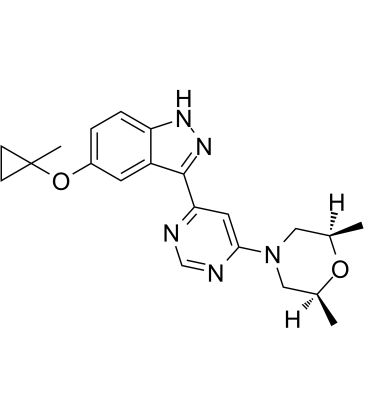| Cas No.: | 1627091-47-7 |
| Synonyms: | MLi2; Mli 2 |
| SMILES: | C[C@@](C1)([H])O[C@](C)([H])CN1C2=CC(C3=NNC4=CC=C(OC5(C)CC5)C=C43)=NC=N2 |
| Formula: | C21H25N5O2 |
| M.Wt: | 379.46 |
| Purity: | >98% |
| Sotrage: | 2 years -20°C Powder, 2 weeks 4°C in DMSO, 6 months -80°C in DMSO |
| Publication: | [1]. Fell MJ, et al. MLi-2, a Potent, Selective, and Centrally Active Compound for Exploring the Therapeutic Potential and Safety of LRRK2 Kinase Inhibition. J Pharmacol Exp Ther. 2015 Dec;355(3):397-409. |
| Description: | MLi-2 is an a potent, highly selective, orally available, brain penetrant inhibitor of LRRK2 with an IC50 of 0.76 nM. |
| Target: | IC50: 0.76 nM (LRRK2)[1] |
| In Vivo: | Acute oral and subchronic dosing in MLi-2 mice results in dose-dependent central and peripheral target inhibition over a 24-hour period as measured by dephosphorylation of pSer935 LRRK2. Treatment of MitoPark mice with MLi-2 is well tolerated over a 15-week period at brain and plasma exposures. Morphologic changes in the lung, consistent with enlarged type II pneumocytes, are observed in MLi-2-treated MitoPark mice[1]. |
| In Vitro: | MLi-2 exhibits exceptional potency in a purified LRRK2 kinase assay in vitro( IC50=0.76 nM), a cellular assay monitoring dephosphorylation of LRRK2 pSer935 LRRK2 (IC50=1.4 nM), and a radioligand competition binding assay (IC50=3.4 nM). MLi-2 has greater than 295-fold selectivity for over 300 kinases in addition to a diverse panel of receptors and ion channels[1]. |
| Kinase Assay: | MLi-2 dose response is prepared by diluting a 10 mM stock of MLi-2 to a top concentration of 98 μM in 100% DMSO followed by serial dilution by 1:2.15 in DMSO nine times. Four hundred nanoliters of each dilution is spotted via a Labcyte Echo onto a 384-well black-sided plate followed by 10 μL of a 2.5 nM enzyme solution in 1xassay buffer. Following a 30-minute incubation at room temperature, the kinase reaction is started with the addition of 10 μL of 800 nM fluorescein-labeled LRRKtide peptide substrate and 186 μM ATP solution in 1x assay buffer. The reaction is allowed to progress at 25°C for 1 hour. The reaction is then stopped by the addition of 20 μL of TR-FRET Dilution Buffer containing 4 nM Tb-labeled anti-phospho LRRKtide antibody and 20 mM EDTA. After an incubation of 1 hour at room temperature, the plate is read on 340, 520 and 495 nm[1]. |
| Animal Administration: | Mice: MLi-2 is suspended in 30% Captisol and administered in a volume of 10 mL/kg. Dose calculations are on the basis of active moiety. Mice receive MLi-2 [1-100 mg/kg; by mouth (PO)], or vehicle 1 hour prior to euthanasia by excess CO2. Immediately following euthanasia, mouse brain cortex is dissected and frozen on a steel plate over dry ice for analysis of pSer935 LRRK2 via Western Blot. Plasma and brain samples are collected and frozen for determination of MLi-2 levels by LC-MS/MS[1]. |
| References: | [1]. Fell MJ, et al. MLi-2, a Potent, Selective, and Centrally Active Compound for Exploring the Therapeutic Potential and Safety of LRRK2 Kinase Inhibition. J Pharmacol Exp Ther. 2015 Dec;355(3):397-409. |

 To enhance service speed and avoid tariff delays, we've opened a US warehouse. All US orders ship directly from our US facility.
To enhance service speed and avoid tariff delays, we've opened a US warehouse. All US orders ship directly from our US facility.




















